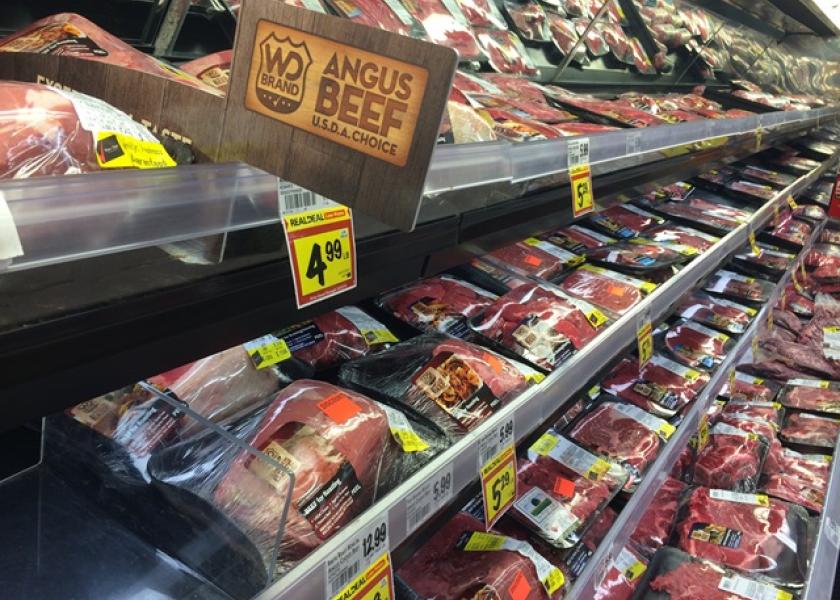Behind the Words: What Meat Labels Mean

Consumers should understand marketing claims on meat products to make informed purchasing decisions.
By: Katie Allen, K-State Research & Extension News
Overwhelmed, confused and unsure are just a few words to describe how many consumers feel when purchasing foods, particularly meat products.
Today, the average meat case at a large retail store has more than 135 different items in it, said Travis O’Quinn, assistant professor of meat science at Kansas State University. Those items differ in meat item type, packaging type and the marketing claims they bear.
“When consumers go into a grocery store, and they’re trying to make a decision about what meat product they want to purchase, many times they’re overwhelmed by the options,” O’Quinn said. “They don’t fully understand what the labeling terms and marketing claims are telling them about the products.”
O’Quinn, who is also a fresh meats specialist for K-State Research and Extension, recently teamed up with Londa Nwadike, food safety specialist for K-State Research and Extension and the University of Missouri Extension, to develop a publication that explains in more detail what meat labels and meat marketing claims mean.
Nwadike said she works closely with family and consumer science agents in local extension offices throughout Kansas and Missouri, who have been getting many questions and comments from consumers such as, “I think I need to pay extra for organic because it’s safer.”
“A lot of times consumers will think that if something is labeled as ‘natural,’ ‘organic’ or ‘raised without antibiotics,’ that it is (microbially) safer,” Nwadike said. “I often tell people if you know what those terms mean, you feel that is important to you and you can afford it, you can buy what you want. We want people to be informed so they are spending their money wisely, getting what they are expecting and aren’t buying something just because it has a particular label.”
Animal production claims vs. product claims
Many marketing claims found on meat labels speak to how the animal from which the product derived was raised, which are animal production claims. Some of these claims might include “naturally raised,” “organic,” “raised without antibiotics,” “raised without added hormones,” “grass-fed” or “free range.”
Other marketing claims on a meat package relate to the product itself, such as “no additives,” “fresh, never frozen,” and claims related to the U.S. Department of Agriculture (USDA) grade, tenderness, age or breed of the animal, and certain branded products.
O’Quinn said from an animal production standpoint, the most easily misunderstood marketing claims relate to the terms “natural” and “naturally raised.”
“When many consumers think of ‘natural,’ they think of a cow in a pasture, how the animal was raised, but that’s not exactly what that term means,” O’Quinn said. “The term ‘natural’ refers to a product that has no artificial ingredients, no preservatives and has been minimally processed. Most meat products for purchase in the meat case qualify for the ‘natural’ labeling claim.”
Conversely, “naturally raised” means the animal was raised without antibiotics, growth promotants and animal byproducts, he said.
For the product itself, consumers probably recognize the USDA grade the most, O’Quinn said. From a beef standpoint, for example, USDA Prime, USDA Choice and USDA Select are official quality grades that segregate meat into groups based on expected eating experience—USDA Prime having the highest expectancy as tender, juicy and flavorful.
Inspected foods typically safe despite marketing claims
Regardless if the claim relates to animal production or the product itself, if it is on the package, the USDA must approve it, O’Quinn said.
“However, materials at the point of sale, and things in and around the meat case are not regulated by the USDA,” he said. “Often we get marketing claims on those materials that confuse consumers further, because (marketers) are using terminology in these areas that is not approved.”
Nwadike said consumers should know that any meat product sold in grocery stores and most other retail locations will be inspected to meet the USDA’s safety standards.
“We do see instances (of food safety breaches) in the news, but overall the meat supply is safe,” she said. “Different labeling and marketing terms are just differentiations of the product. These terms don’t mean the product is more safe or less safe from a microbial perspective.”
Access the publication “Meat Product Labeling and Marketing: What Do All Those Words Really Mean?” online through the K-State Research and Extension Bookstore or at your local extension office.







